This article was published in Scientific American’s former blog network and reflects the views of the author, not necessarily those of Scientific American
Today – June 21st – is World Giraffe Day. Ever one to jump on a bandwagon and join in the fun, I thought I’d take advantage and re-post the following excerpt of text. It describes the time Don Henderson and I decided that we should work on a paper that analysed the swimming and flotation abilities of giraffes, the published result being Henderson & Naish (2010) (see also Naish (2010) for a popular version). The original, full-length article appeared on Tet Zoo ver 2 back in June 2010. For it, and other giraffe-themed Tet Zoo articles, see the links at the bottom.
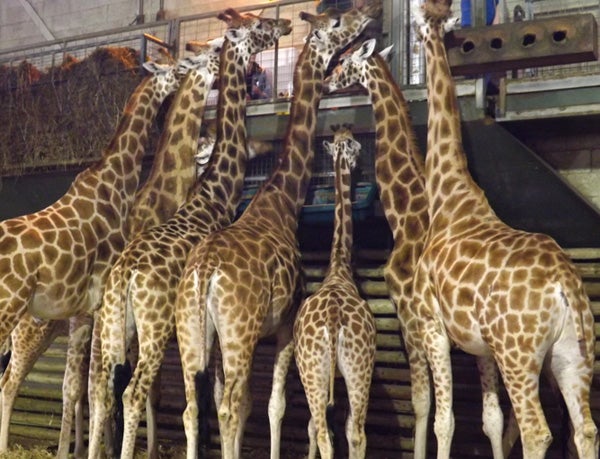
Giraffes are always firm favourites at the zoo. These animals are at Marwell, UK. Photo by Darren Naish.
So, Don and I wanted to model the flotation dynamics and swimming abilities of a giraffe. There’s a long back-story here, as I’m sure you might imagine. But let’s skip that and get to the meat-and-potatoes… how do you model the flotation dynamics and swimming abilities of a giraffe?
On supporting science journalism
If you're enjoying this article, consider supporting our award-winning journalism by subscribing. By purchasing a subscription you are helping to ensure the future of impactful stories about the discoveries and ideas shaping our world today.
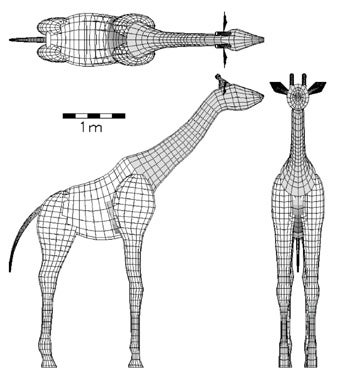
Don's CG mesh model of a giraffe. Image from Henderson & Naish (2010).
Modelling a digital giraffe. To start with, it’s clear that we wouldn’t actually be able to fully test the swimming abilities of giraffes (given that we couldn’t accurately replicate or estimate all the details of aquatic movement in a giraffe), but we could test the floating abilities, and hence indirectly test the potential swimming abilities.
Giraffes are complicated objects, and modelling them digitally is fraught with difficulty. A 3D giraffe model was generated via the digital slicing method described by Henderson (1999) (our model isn’t definitely meant to depict any of the Giraffa taxa in particular; yes, we’re well aware of the suggestion that the several ‘subspecies’ conventionally included in G. camelopardalis might warrant species status). Several things were done to make the model more like a real giraffe: ears, ossicones and the fleshy part of the tail were created, and a synthesized reticulated pattern was created because it made the model look so much better. Don has actually pioneered a very interesting technique for generating regularly spaced polygons and/or blotches – it has some really interesting implications that I can’t discuss here (for more information, see Appendix A in Henderson & Naish (2010)).
Two details of a digital model are particularly important when testing simulated buoyancy: density and lung volume. Giraffe limb bones are slightly thicker than those of other artiodactyls (van Schalwyk et al. 2004), so their density was set as being somewhat higher than the rest of the body (1050 g/l vs 1000 g/l). The giraffe’s most notable feature – its neck – was set at 850 g/l, as is typical for hoofed mammals. As we’ll see, the high density of the distal parts of the limbs and low density of the neck and head seem to have implications for the floating and swimming behaviour of giraffes.
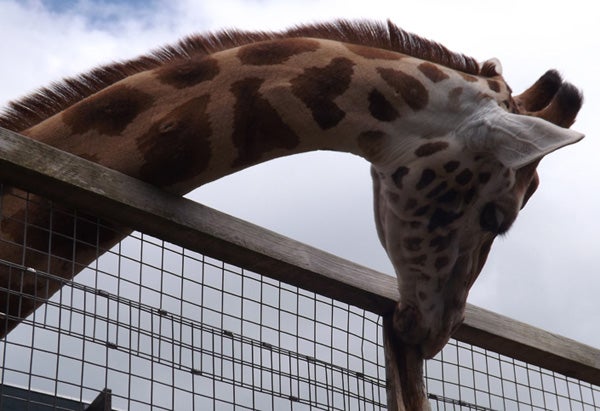
One of the things that most people know about giraffes is that they have a long neck. This captive individual is gnawing at the wood that forms part of the fencing around its enclosure. Photo by Darren Naish.
The lungs of giraffes are peculiar in size and shape (as you’ll know if you watched Inside Nature’s Giants), and exactly how large they are has long been a point of controversy: estimates of their volume in an ‘average’ giraffe (of 1.1 tons) have ranged from a low of 10 litres (Patterson et al. 1957) to a high of 47 litres (Robin et al. 1960). By scaling up from a horse to a big, male, 1.6 ton giraffe, an enormous projected lung volume of 141 litres was obtained (lung volume is about 6 litres in humans). Projections of this size have long been thought to be erroneous, however (Stahl 1967). A probable lung size about eight times that of a human is generally thought about right… in which case about 48 litres is correct for a 1.1 ton giraffe; this scales to 74 litres for a 1.6 ton giraffe. Obviously, there’s much uncertainty here and more data is needed.
Don also modelled a horse Equus caballus - shown here - as a control for the experiment.
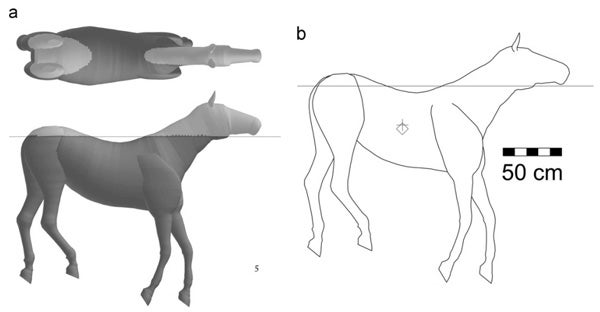
Our floating horse model, positioned at equilibrium. Note that this is a floating pose, not a swimming pose. From Henderson & Naish (2010).
Can a giraffe float? Given that the horse model seems to accurately predict the real-life buoyancy of floating and swimming horses (Henderson & Naish 2010), we’re fairly confident that the giraffe model mimics the real thing. By rising the simulated water level around the giraffe model [as shown in the figure below], it was found that an adult giraffe would start to float at a water depth of about 2.8 m. It seems that the hindlimbs would leave the substrate before the forelimbs, raising the possibility that giraffes in deep water might be able to pole themselves along with their forelimbs alone.
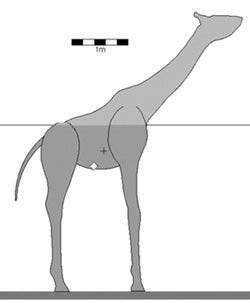
At a certain water level, the digital giraffe began to be lifted off the substrate. The image shown here depicts the model before buoyancy had been achieved. From Henderson & Naish (2010).
But if the water becomes deeper still, what happens when the giraffe lifts off the substrate and begins to float? In a simulated floating posture, the hips are higher than the shoulders and the heavy forelimbs and short body mean that the foreparts are angled downwards relative to the horizontal. In turn, this means that the neck is rotated downwards and has to be held near-horizontally and just at, or under, the water surface: so far as we can tell, it doesn’t seem possible for giraffes to swim with the neck held erect out of the water. The horizontal neck posture then means that the head has to be held at a very awkward, upward-angled posture (assuming, of course, that the animal wants to keep its eyes and nostrils above the surface).
It’s well known that the giraffe head – particularly that of old males – is dense-boned and fairly heavy, but the cavities in the head and the long trachea and oesophagus make the head and neck rather less dense than the rest of the animal (850 g/l vs 1000 g/l or more). The neck and head account for about 10.8% of the animal’s total mass, but it seems that their low density actually prevents the animal’s anterior part from being even further down in the water (Henderson & Naish 2010). The overall density of the giraffe is higher than that of the horse, making the animal closer to being negatively buoyant and also making it sit lower in the water than the horse model.
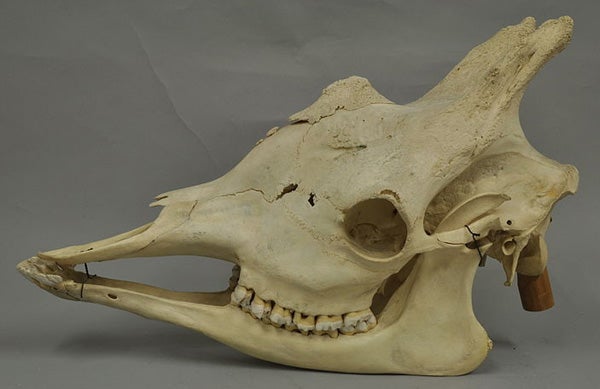
It's well known that giraffes grow a lot of bone on the top of the skull as they age - males especially. The head may thus be really heavy. Photo by Klaus Rassinger and Gerhard Cammerer, from here, CC BY-SA 3.0.
In conclusion, it seems that giraffes can float: there’s no reason to assume that they might ‘sink like stones’, nor was there any indication from the model that it was particularly unstable and prone to capsizing. But the model’s posture in the water is low and hardly ideal, and looks downright uncomfortable. What might this mean for swimming ability?
Bad at swimming, or really bad at swimming? The high mean density of the giraffe and the peculiar and difficult horizontal-necked posture the model adopts in water suggest that giraffes would not perform well in water. A large amount of drag and rotational inertia also afflict the model: in fact, it suffered from 13.5% more frictional drag than the horse model (Henderson & Naish 2010). We also suggest that the unusual gait practised by giraffes may well impair their swimming abilities. Giraffes on land use a synchronous movement of the neck and limbs where backwards and forwards movement of the neck is closely linked to the limb movements. But, with its neck constrained to a sub-horizontal posture where little or no backwards and forwards movement is possible, a swimming giraffe cannot adopt a gait like the one it uses on land.
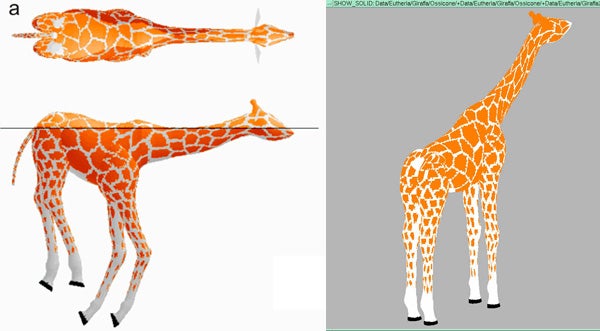
At left: CG model of a floating giraffe. It's really not built well for floating, let alone swimming. Image from Henderson & Naish (2010). At right: the colour version of Don's model in standing pose.
Quadrupedal mammals – like the horse – typically swim with a trot like that used on land, so it seems reasonable to assume that swimming giraffes should try and swim with a ‘terrestrial’-style gait too. However, note that this argument isn’t completely conclusive, because the swimming gaits of some quadrupedal mammals are very different from their walking or running gaits. Nevertheless, I still think that our assumption is a reasonable one.
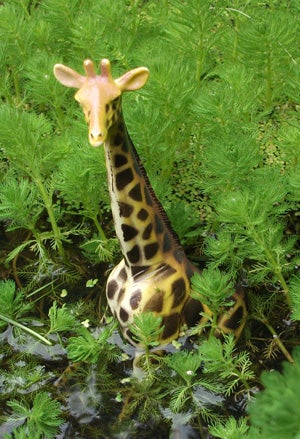
This is, so far, the only giraffe in water I've seen (outside of TV commercials). Photo by Darren Naish.
Positioned in the water in an uncomfortable pose, afflicted with a relatively high mean density, suffering from substantially high frictional drag, and unable to raise and lower its neck and hence unable to adopt a synchronous gait, we conclude that giraffes would be very poor swimmers, and that it might be assumed that they would avoid this activity if at all possible. Looked at another way, we conclude that giraffes can swim, but not at all well.
For previous Tet Zoo articles on giraffes, see...
Inside Nature’s Giants part IV: the incredible anatomy of the giraffe
Testing the flotation dynamics and swimming abilities of giraffes by way of computational analysis
Refs - -
Henderson, D. M. 1999. Estimating the masses and centers of mass of extinct animals by 3-D mathematical slicing. Paleobiology 25, 88-106.
Naish, D. 2010. Will it float? Scientific American 304 (1), 22.
Patterson, J. L., Warren, J. V., Doyle, J. T., Gauer, O. H., Keen, E. N. & Goetz, R. H. 1957. Circulation and respiration in the giraffe. The Journal of Clinical Investigation 36, 919.
Robin, E. D., Corson, J. M. & Dammin, G. J. 1960. The respiratory dead space of the giraffe. Nature 186, 24-26.
Stahl, W. R. 1967. Scaling of respiratory variables in mammals. Journal of Applied Physiology 22, 453-460.
van Schalkwyk, O. L., Skinner, J. D. & Mitchell, G. 2004. A comparison of the bone density and morphology of giraffe (Giraffa camelopardalis) and buffalo (Syncerus caffer) skeletons. Journal of Zoology 264, 307-315.